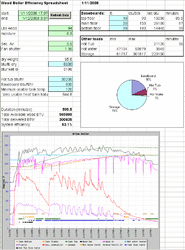I am wondering if anyone out there has actually done any testing of the thermal performance of gasifier wood boilers.
This would require weighing the wood and its moisture content and then seeing how that related to what a storage tank
actually received as heat. (with no heat being removed for a testing period)
A lot of manufacturers talk about 90% efficiency, but that is what they say, not what field experience shows.
We have done this at the University of Maine and were quite pleased to hit 70%. I wonder if this was primitive compared to today's boilers
or is everyone being extremely optomistic?
Tom in Maine--where rain is the new sun!
This would require weighing the wood and its moisture content and then seeing how that related to what a storage tank
actually received as heat. (with no heat being removed for a testing period)
A lot of manufacturers talk about 90% efficiency, but that is what they say, not what field experience shows.
We have done this at the University of Maine and were quite pleased to hit 70%. I wonder if this was primitive compared to today's boilers
or is everyone being extremely optomistic?
Tom in Maine--where rain is the new sun!


